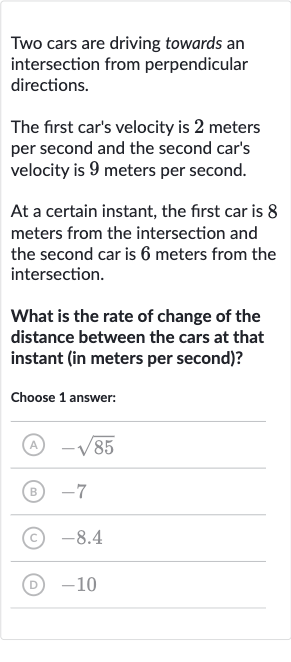AI tutor
Welcome to Bytelearn!
Let’s check out your problem:

Two cars are driving towards an intersection from perpendicular directions.The first car's velocity is meters per second and the second car's velocity is meters per second.At a certain instant, the first car is meters from the intersection and the second car is meters from the intersection.What is the rate of change of the distance between the cars at that instant (in meters per second)?Choose answer:(A) (B) (C) .(D)
Full solution
Q. Two cars are driving towards an intersection from perpendicular directions.The first car's velocity is meters per second and the second car's velocity is meters per second.At a certain instant, the first car is meters from the intersection and the second car is meters from the intersection.What is the rate of change of the distance between the cars at that instant (in meters per second)?Choose answer:(A) (B) (C) .(D)
- Define Distances: Let's call the distance between the first car and the intersection , and the distance between the second car and the intersection . We know that meters and meters.
- Apply Pythagorean Theorem: The distance between the two cars can be found using the Pythagorean theorem, since they are approaching the intersection from perpendicular directions. Let's call this distance .So, .
- Calculate Distance: Plugging in the values, we get .
- Find Rate of Change: Taking the square root of both sides to find , we get meters.
- Derive Rate of Change: Now, we need to find the rate of change of this distance with respect to time. We can use the derivative of the distance function with respect to time, which is the sum of the derivatives of and with respect to time, since they are both functions of time.
- Derive Rate of Change: Now, we need to find the rate of change of this distance with respect to time. We can use the derivative of the distance function with respect to time, which is the sum of the derivatives of and with respect to time, since they are both functions of time.The rate of change of with respect to time is the velocity of the first car, which is meters per second (negative because it's approaching the intersection). Similarly, the rate of change of with respect to time is the velocity of the second car, which is meters per second.
- Derive Rate of Change: Now, we need to find the rate of change of this distance with respect to time. We can use the derivative of the distance function with respect to time, which is the sum of the derivatives of and with respect to time, since they are both functions of time.The rate of change of with respect to time is the velocity of the first car, which is meters per second (negative because it's approaching the intersection). Similarly, the rate of change of with respect to time is the velocity of the second car, which is meters per second.The rate of change of the distance with respect to time is the derivative of the square root of with respect to time. Using the chain rule, we get .
- Derive Rate of Change: Now, we need to find the rate of change of this distance with respect to time. We can use the derivative of the distance function with respect to time, which is the sum of the derivatives of and with respect to time, since they are both functions of time.The rate of change of with respect to time is the velocity of the first car, which is meters per second (negative because it's approaching the intersection). Similarly, the rate of change of with respect to time is the velocity of the second car, which is meters per second.The rate of change of the distance with respect to time is the derivative of the square root of with respect to time. Using the chain rule, we get .Plugging in the values, we get .
- Derive Rate of Change: Now, we need to find the rate of change of this distance with respect to time. We can use the derivative of the distance function with respect to time, which is the sum of the derivatives of and with respect to time, since they are both functions of time.The rate of change of with respect to time is the velocity of the first car, which is meters per second (negative because it's approaching the intersection). Similarly, the rate of change of with respect to time is the velocity of the second car, which is meters per second.The rate of change of the distance with respect to time is the derivative of the square root of with respect to time. Using the chain rule, we get .Plugging in the values, we get .Simplifying, we get meters per second.
More problems from Solve linear equations with variables on both sides: word problems
QuestionGet tutor help
